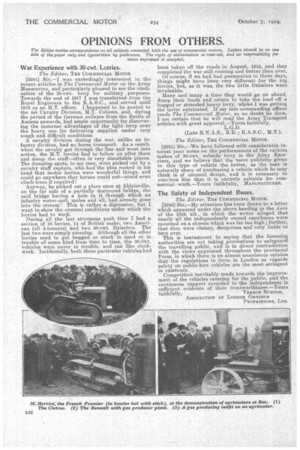OPINIONS FROM OTHERS.
Page 24

If you've noticed an error in this article please click here to report it so we can fix it.
The Editor invites correspondence on all subjects connected with the sege of commercial motors. Letters should be on one side of the paper only and typewritten by preference. The right of abbreviation as reserved, and no responsibility for views expressed is accepted.
War Experience with 30-cwt. Lorries.
. The Editor, THE COMMERCIAL MOTOR.
[2284] Sir,—I was exceedingly interested in the recent articles in The Commercal Motor on the Army Manceuvres, and particularly pleased to see the vindication of the 30-cwt. lorry for military purposes. Towards the end of 1917 I was transferred from the Royal Engineers to the R.A.S.C., and served until 1919 as an M.T. officer. I happened to be posted to the 1st Cavalry Division, M.T. Column, and, during the period of the German collapse from the Battle of Amiens onwards, had ample opportunity for discovering the immense advantages of the light lorry over the heavy one for delivering supplies under very rough and difficult conditions.
A cavalry division during the war, unlike an infantry division, had no horse transport. As. a result, when the cavalry got through the line and went into action, the M.T. lorries had to follow on after them and dump the stuff—often in very u'neuitable places. The dumping spots, in my case, were picked out by a cavalry staff captain, who had the idea rooted in his head that motor lorries were wonderful things, and could go anywhere that horses could not—could even climb trees if required!
Anyway, he picked out a place once at AblainvilIe, on the far side of a partially destroyed bridge, the said bridge having a hole in it through which an infantry water-cart, mules and all, had already gone into the stream! This is rather a digression,. but I want to show the unusual conditions under which the lorries had to work.
During all the last strenuous push time I had a section of 18 lorries, 14 of British make,. two American (all 4-tonners) and two 30-cwt. Daimlers. The last two were simply amazing. Although all the other lorries used to get bogged or stuck in sand or in trouble of some kind from time to time, the 30-cwt. vehicles were never in trouble, and ran like clockwork. Incidentally, both these particular vehicles had been taken off the roads in August, 1914, and they completed the war still running and better than ever.
Of course, if we had had pneumatics in those days, things might have been very different for the big lorries, but, as it was, the two little Daimlers were invaluable.
Many and many a time they would go on ahead, dump their loads and return to take the load off a bogged or stranded heavy lorry, whilst I was getting the latter extricated. If my late commanding officer reads The Commercial Motor, as no doubt he does, I am certain that he will read the Army Transport articles with great approval.—Yours faithfully,
L. .D.
(Late R.N. A. S. , RE.; R. A.S. C., M.T.).
The Editor, THE COMMERCIAL MOTOR.
[2285] Sir,—We have followed with considerable interest your notes on the performances of the various makes of 30-cwt. subsidy lorry in the Army Exercises, and we believe that the more publicity given to this type of vehicle the better, as the user is naturally chary of purchasing a vehicle which he may think is of unusual design, and it is necessary to convince him that it is entirely suitable for commercial work.—Yours faithfully, MANUFACTURER.
The Safety of Independent Buses.
The Editor, THE COMMERCIAL MOTOR.
[2280] Sir,—My attention has been drawn to a letter which appeared under the above heading in the Auto of the 25th ult.' in which the writer alleged that nearly all the independently owned omnibuses were mounted on a chassis which was far too high ; further, that they were clumsy, dangerous and very liable to turn over.
This is tantamount to saying that the licensing authorities are not taking precautions to safeguard the travelling public, and is in direct contradiction with the views expressed throughout the provincial Press, in which there is an almost unanimous opinion that the regulations in force in London as regards safety on public-hire vehicles are the most stringent in existence.
Competition inevitably tends towards the improvement of the vehicles catering for the public, and the continuous support accorded to the independents is sufficient evidence of their trustworthiness.—Yours faithfully, VERNON BURTON, ASSOCIATION OF LONDON OMNISITS PROPRIETORS, LTD.






























